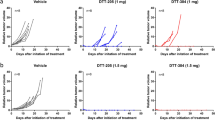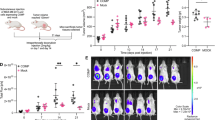Abstract
The exposure of calreticulin (CRT) on the plasma membrane can precede anthracycline-induced apoptosis and is required for cell death to be perceived as immunogenic. Mass spectroscopy, immunofluorescence and immunoprecipitation experiments revealed that CRT co-translocates to the surface with another endoplasmic reticulum-sessile protein, the disulfide isomerase ERp57. The knockout and knockdown of CRT or ERp57 inhibited the anthracycline-induced translocation of ERp57 or CRT, respectively. CRT point mutants that fail to interact with ERp57 were unable to restore ERp57 translocation upon transfection into crt−/− cells, underscoring that a direct interaction between CRT and ERp57 is strictly required for their co-translocation to the surface. ERp57low tumor cells generated by retroviral introduction of an ERp57-specific shRNA exhibited a normal apoptotic response to anthracyclines in vitro, yet were resistant to anthracycline treatment in vivo. Moreover, ERp57low cancer cells (which failed to expose CRT) treated with anthracyclines were unable to elicit an anti-tumor response in conditions in which control cells were highly immunogenic. The failure of ERp57low cells to elicit immune responses and to respond to chemotherapy could be overcome by exogenous supply of recombinant CRT protein. These results indicate that tumors that possess an intrinsic defect in the CRT-translocating machinery become resistant to anthracycline chemotherapy due to their incapacity to elicit an anti-cancer immune response.
Similar content being viewed by others
Log in or create a free account to read this content
Gain free access to this article, as well as selected content from this journal and more on nature.com
or
Accession codes
Abbreviations
- Bac:
-
bacitracin
- CRT:
-
calreticulin
- DAPI:
-
4′,6-diamidino-2-phenylindole
- DC:
-
dendritic cells
- ER:
-
endoplasmic reticulum
- FBS:
-
fetal bovine serum
- MHC:
-
major histocompatibility complex
- PBS:
-
phosphate-buffered saline
- PDI:
-
protein disulfide isomerases
- PFA:
-
paraformaldehyde
- PI:
-
propidium iodide
- PM:
-
plasma membrane
- rec.CRT:
-
recombinant calreticulin
- recERp57:
-
recombinant ERp57
References
Casares N, Pequignot MO, Tesniere A, Ghiringhelli F, Roux S, Chaput N et al. Caspase-dependent immunogenicity of doxorubicin-induced tumor cell death. J Exp Med 2005; 202: 1691–1701.
Obeid M, Tesniere A, Ghiringhelli F, Fimia GM, Apetoh L, Perfettini JL et al. Calreticulin exposure dictates the immunogenicity of cancer cell death. Nat Med 2007; 13: 54–61.
Obeid M, Panaretakis T, Joza N, Tufi R, Tesniere A, van Endert P et al. Calreticulin exposure is required for the immunogenicity of gamma-irradiation and UVC light-induced apoptosis. Cell Death Differ 2007; 14: 1848–1850.
Obeid M, Tesniere A, Panaretakis T, Tufi R, Joza N, van Endert P et al. Ecto-calreticulin in immunogenic chemotherapy. Immunol Rev 2007; 220: 22–34.
Apetoh L, Ghiringhelli F, Tesniere A, Obeid M, Ortiz C, Criollo A et al. Toll-like receptor 4-dependent contribution of the immune system to anticancer chemotherapy and radiotherapy. Nat Med 2007; 13: 1050–1059.
Apetoh L, Ghiringhelli F, Tesniere A, Obeid M, Ortiz C, Criollo A et al. Toll-like receptor 4-dependent contribution of the immune system to anticancer chemotherapy and radiotherapy. Nat Med 2007; 13: 1050–1059.
Zitvogel L, Apetoh L, Ghiringhelli F, Kroemer G . Immunological aspects of cancer chemotherapy. Nat Rev 2008; 8: 59–73.
Groenendyk J, Lynch J, Michalak M . Calreticulin, Ca2+, and calcineurin – signaling from the endoplasmic reticulum. Mol Cells 2004; 17: 383–389.
Coppolino MG, Woodside MJ, Demaurex N, Grinstein S, St-Arnaud R, Dedhar S . Calreticulin is essential for integrin-mediated calcium signalling and cell adhesion. Nature 1997; 386: 843–847.
Kwon MS, Park CS, Choi K, Ahnn J, Kim JI, Eom SH et al. Calreticulin couples calcium release and calcium influx in integrin-mediated calcium signaling. Mol Biol Cell 2000; 11: 1433–1443.
Oliver JD, Roderick HL, Llewellyn DH, High S . ERp57 functions as a subunit of specific complexes formed with the ER lectins calreticulin and calnexin. Mol Biol Cell 1999; 10: 2573–2582.
Silvennoinen L, Myllyharju J, Ruoppolo M, Orru S, Caterino M, Kivirikko KI et al. Identification and characterization of structural domains of human ERp57: association with calreticulin requires several domains. J Biol Chem 2004; 279: 13607–13615.
Holaska JM, Black BE, Rastinejad F, Paschal BM . Ca2+-dependent nuclear export mediated by calreticulin. Mol Cell Biol 2002; 22: 6286–6297.
Michalak M, Burns K, Andrin C, Mesaeli N, Jass GH, Busaan JL et al. Endoplasmic reticulum form of calreticulin modulates glucocorticoid-sensitive gene expression. J Biol Chem 1996; 271: 29436–29445.
Obeid M, Panaretakis T, Tesniere A, Joza N, Tufi R, Apetoh L et al. Leveraging the immune system during chemotherapy: moving calreticulin to the cell surface converts apoptotic death from ‘silent’ to immunogenic. Cancer Res 2007; 67: 7941–7944.
Tufi R, Panaretakis T, Bianchi K, Criollo A, Fazi B, Di Sano F et al. Reduction of endoplasmic reticulum Ca(2+) levels favors plasma membrane surface exposure of calreticulin. Cell Death Differ 2008; 15: 274–282.
Berwin B, Delneste Y, Lovingood RV, Post SR, Pizzo SV . SREC-I, a type F scavenger receptor, is an endocytic receptor for calreticulin. J Biol Chem 2004; 279: 51250–51257.
Gardai SJ, McPhillips KA, Frasch SC, Janssen WJ, Starefeldt A, Murphy-Ullrich JE et al. Cell-surface calreticulin initiates clearance of viable or apoptotic cells through trans-activation of LRP on the phagocyte. Cell 2005; 123: 321–334.
Duus K, Pagh RT, Holmskov U, Hojrup P, Skov S, Houen G . Interaction of calreticulin with CD40 ligand, TRAIL and Fas ligand. Scand J Immunol 2007; 66: 501–507.
Gallego MA, Joseph B, Hemstrom TH, Tamiji S, Mortier L, Kroemer G et al. Apoptosis-inducing factor determines the chemoresistance of non-small-cell lung carcinomas. Oncogene 2004; 23: 6282–6291.
Garbi N, Hammerling G, Tanaka S . Interaction of ERp57 and tapasin in the generation of MHC class I-peptide complexes. Curr Opin Immunol 2007; 19: 99–105.
Hirano N, Shibasaki F, Sakai R, Tanaka T, Nishida J, Yazaki Y et al. Molecular cloning of the human glucose-regulated protein ERp57/GRP58, a thiol-dependent reductase. Identification of its secretory form and inducible expression by the oncogenic transformation. Eur J Biochem/FEBS 1995; 234: 336–342.
Antoniou AN, Ford S, Alphey M, Osborne A, Elliott T, Powis SJ . The oxidoreductase ERp57 efficiently reduces partially folded in preference to fully folded MHC class I molecules. EMBO J 2002; 21: 2655–2663.
Leys CM, Nomura S, LaFleur BJ, Ferrone S, Kaminishi M, Montgomery E et al. Expression and prognostic significance of prothymosin-alpha and ERp57 in human gastric cancer. Surgery 2007; 141: 41–50.
Turano C, Coppari S, Altieri F, Ferraro A . Proteins of the PDI family: unpredicted non-ER locations and functions. J Cell Physiol 2002; 193: 154–163.
Bohring C, Krause E, Habermann B, Krause W . Isolation and identification of sperm membrane antigens recognized by antisperm antibodies, and their possible role in immunological infertility disease. Mol Hum Reprod 2001; 7: 113–118.
Gao B, Adhikari R, Howarth M, Nakamura K, Gold MC, Hill AB et al. Assembly and antigen-presenting function of MHC class I molecules in cells lacking the ER chaperone calreticulin. Immunity 2002; 16: 99–109.
Martin V, Groenendyk J, Steiner SS, Guo L, Dabrowska M, Parker JM et al. Identification by mutational analysis of amino acid residues essential in the chaperone function of calreticulin. J Biol Chem 2006; 281: 2338–2346.
Mimura Y, Mimura-Kimura Y, Doores K, Golgher D, Davis BG, Dwek RA et al. Folding of an MHC class II-restricted tumor antigen controls its antigenicity via MHC-guided processing. Proc Natl Acad Sci USA 2007; 104: 5983–5988.
Homma S, Komita H, Sagawa Y, Ohno T, Toda G . Antitumour activity mediated by CD4+ cytotoxic T lymphocytes against MHC class II-negative mouse hepatocellular carcinoma induced by dendritic cell vaccine and interleukin-12. Immunology 2005; 115: 451–461.
Chaput N, De Botton S, Obeid M, Apetoh L, Ghiringhelli F, Panaretakis T et al. Molecular determinants of immunogenic cell death: surface exposure of calreticulin makes the difference. J Mol Med (Berlin, Germany) 2007; 85: 1069–1076.
Zhang Y, Baig E, Williams DB . Functions of ERp57 in the folding and assembly of major histocompatibility complex class I molecules. J Biol Chem 2006; 281: 14622–14631.
Zamzami N, El Hamel C, Maisse C, Brenner C, Munoz-Pinedo C, Belzacq AS et al. Bid acts on the permeability transition pore complex to induce apoptosis. Oncogene 2000; 19: 6342–6350.
Castedo M, Ferri K, Roumier T, Metivier D, Zamzami N, Kroemer G . Quantitation of mitochondrial alterations associated with apoptosis. J Immunol Methods 2002; 265: 39–47.
Gottardi CJ, Dunbar LA, Caplan MJ . Biotinylation and assessment of membrane polarity: caveats and methodological concerns. Am J Physiol 1995; 268: F285–F295.
Hanwell D, Ishikawa T, Saleki R, Rotin D . Trafficking and cell surface stability of the epithelial Na+ channel expressed in epithelial Madin–Darby canine kidney cells. J Biol Chem 2002; 277: 9772–9779.
Medzihradszky KF, Campbell JM, Baldwin MA, Falick AM, Juhasz P, Vestal ML et al. The characteristics of peptide collision-induced dissociation using a high-performance MALDI-TOF/TOF tandem mass spectrometer. Anal Chem 2000; 72: 552–558.
Gueldener U, Heinisch J, Koehler GJ, Voss D, Hegemann JH . A second set of loxP marker cassettes for Cre-mediated multiple gene knockouts in budding yeast. Nucleic Acids Res 2002; 30: e23.
Sheff MA, Thorn KS . Optimized cassettes for fluorescent protein tagging in Saccharomyces cerevisiae. Yeast (Chichester, England) 2004; 21: 661–670.
Acknowledgements
We thank Dr Marek Michalak for the WT and crt−/− MEF and the CRT constructs. We thank Dr Natalio Garbi for the WT and erp57−/− MEF. GK is supported by the Ligue Nationale contre le Cancer (Equipe labellisée), European Commission (Active p53, Apo-Sys, RIGHT, TransDeath, ChemoRes, DeathTrain), Cancéropôle Ile-de-France, Fondation de France and Fondation pour la Recherche Médicale, TP is supported by the Swedish Research Council (Vetenskapsradet), NJ is supported by NSERC (Canada), AT is supported by Poste d'accueil INSERM and OK is supported by EMBO. K-WF and MD are grateful to Fonds zur Förderung der wissenschaftlichen Forschung (Austria) for grant ‘Molecular Enzymology’. FM is grateful to Fonds zur Förderung der wissenschaftlichen Forschung (Austria) for grant S-9304-B05. MP is partially supported by grants from Ministero della Salute and AIRC.
Author information
Authors and Affiliations
Corresponding author
Additional information
Edited by P Bouillet
Supplementary Information accompanies the paper on Cell Death and Differentiation website (http://www.nature.com/cdd)
Supplementary information
Rights and permissions
About this article
Cite this article
Panaretakis, T., Joza, N., Modjtahedi, N. et al. The co-translocation of ERp57 and calreticulin determines the immunogenicity of cell death. Cell Death Differ 15, 1499–1509 (2008). https://doi.org/10.1038/cdd.2008.67
Received:
Revised:
Accepted:
Published:
Issue date:
DOI: https://doi.org/10.1038/cdd.2008.67
Keywords
This article is cited by
-
Calreticulin: a quintessential multifaceted protein with therapeutic potential
Journal of Proteins and Proteomics (2023)
-
Local anesthetics and immunotherapy: a novel combination to fight cancer
Seminars in Immunopathology (2023)
-
Tipping the immunostimulatory and inhibitory DAMP balance to harness immunogenic cell death
Nature Communications (2020)
-
STAT3 inhibitory stattic enhances immunogenic cell death induced by chemotherapy in cancer cells
DARU Journal of Pharmaceutical Sciences (2020)
-
Ecto-Calreticulin is essential for an efficient immunogenic cell death stimulation in mouse melanoma
Genes & Immunity (2019)



